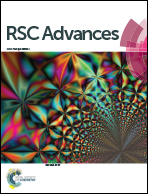Fabrication and electrochemical performance of novel hollow microporous carbon nanospheres†
Abstract
Development of facile synthetic procedures for the fabrication of well-defined hollow carbon nanospheres with a highly porous shell structure is still a very important but really challenging issue. Herein, we report a facile hypercrosslinking strategy to prepare hollow microporous carbon nanospheres with a BET surface area as high as 1166 m2 g−1. SiO2@polystyrene core–shell nanospheres were first prepared, and then were treated through a hypercrosslinking reaction to provide the polystyrene shell with well-developed microporosity. Moreover, the as-constructed hypercrosslinked shell structure ensures a good framework carbonizability and nanostructure inheritability during the high-temperature carbonization process. The porous structure and morphology of the resulting hollow microporous carbon nanospheres can be easily tailored by varying the hypercrosslinking and carbonization conditions. Due to the rational integration of a highly microporous shell structure and a well-defined hollow spherical morphology in the nanometer range, the hollow microporous carbon nanospheres prepared here show good electrochemical performances as active electrodes of lithium ion batteries and supercapacitors.


 Please wait while we load your content...
Please wait while we load your content...